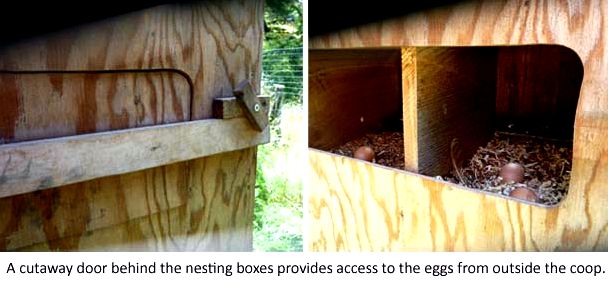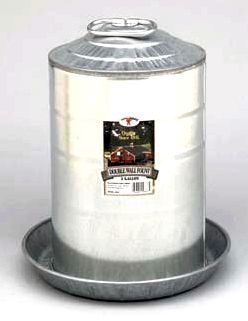Navigation article:
- 1. Building the henhouse directly on the floor
- 2. Not supplying outdoors use of roosting boxes.
- 3. Utilizing a bucket for water
- 4. Not big enough a rooster to hen ratio
- 5. Not counting the wild birds every night
- 6. Not enforcing an “on-leash” insurance policy for visitors with dogs
- Know Your Plastics | GOOD

1. Building the henhouse directly on the floor
I built our first chicken house using recycled lumber and chicken wire (chicken mesh), and hang it directly on the floor. By doing this, I reasoned, the wild birds could scratch and peck in the ground for bugs along with other chicken delights, as well as their poops works in to the ground underneath the litter of straw. I figured this arrangement would have them occupied and happy once they were alone.
Raccoons and mink persistently attempted to burrow underneath the side from the coop, and lastly a mink been successful, which ended up costing the flock. It appeared like I had been always twiddling with the bottom of the dwelling to help keep out predators, whenever a simple elevated floor having a ramp could be more efficient. Today there exists a coop that is elevated 4’ off the floor having a drop-lower floor for simple cleaning.
Using rough recycled lumber seemed to be an error, because it couldn’t be effectively washed lower or cleaned. Chicken coops must have smooth surfaces, colored or whitewashed, that are simple to keep clean and maintain.
2. Not supplying outdoors use of roosting boxes.
Our first chicken house was spacious and tall enough for an individual just to walk inside. I built a row of four nesting boxes in a single a part of coop in which the hens would lay their eggs, and every day someone walked in to the coop to gather the new eggs. This labored fine initially, but soon the children were arriving from collecting the eggs using their gumboots soiled with chicken poop in the litter around the coop floor. And also the daily egg collection appeared to become an invasion around the hens because they milled concerning the coop awaiting an available lounging box.
It had been years before we recognized the apparent! Put a dent port around the outdoors from the coop which utilized the row of nesting boxes. By doing this there’s you don’t need to go into the coop or walk-through the litter, and also the boxes were built sufficient so there wasn’t any bending lower to determine in to the boxes. Today, collecting eggs is neat and simple, and also the hens are undisturbed.

3. Utilizing a bucket for water
Initially we used a typical 9” tall plastic bucket for that chickens water. This size bucket held enough water for a few days for the initial flock of hens, also it was excessive to become fouled by chicken poop and overweight, when the vast majority-full, to become tipped over. Every couple of days I possibly could use the coop and alter water. What may go wrong?

After I checked the coop a couple of days later, the bucket was on its side among a fouled puddle that the wild birds were consuming. Rather of standing and consuming, the wild birds jumped as much as take a seat on the rim from the bucket where they might tilt their heads downwards to consume. This enabled these to poop within the water. When the level dropped a couple of inches, the very best-heavy bucket tipped and spilled.
Chickens will go a couple of days without feed however they need water daily. They easily succumb to lack of fluids. The very best means to fix supplying a stable reliable way to obtain water is by using a dangling water bucket, also known as a waterer or perhaps a fount. The narrow circular trough prevents the wild birds from hopping up since there isn’t any room to sit down. Having a hanging bucket, water stays clean and could be left untended for any week or longer.
4. Not big enough a rooster to hen ratio
We first began raising chickens with 6 hens. Following a couple of several weeks we made the decision to include a rooster towards the flock, so we received a large healthy rooster in a local 4H club meet. The rooster was an energetic mater and before lengthy the hens looked ragged. Both had bald spots on the rear of their heads and featherless patches lying on their backs. The wild birds grew to become run lower and irritated, constantly attempting to run in the rooster. Their egg lounging grew to become sporadic.
The perfect rooster to hen ratio is about 1:12, with respect to the nature from the rooster. Our rooster over-mated the flock and grew to become so aggressive he even challenged me after i walked in to the chicken run. We couldn’t manage to double our flock to support the rooster, and within some time he was delivered to the stew pot and peace was restored within the henhouse.
5. Not counting the wild birds every night
Every night right before dark the chickens know it’s time to enter the coop. It had been a regular evening chore for among the kids to operate out and shut the coop door to safeguard them from raccoons. Shut the doorway, fix the latch, what may go wrong?
One morning when going outside to spread out the coop, a chicken had been outdoors experiencing the morning hours sun. Apparently this hen made the decision to go camping underneath the shrubbery the night time before. Actually, this can be a common practice with chickens. Whenever a hen will get broody, she might want to be undisturbed by egg gatherers and can locate a hiding place to roost. The hen will remain together with her new nest and won’t enter in the coop during the night. But camping outdoors during the night leaves the hen susceptible to predators, so we lost a couple of wild birds prior to making it a typical practice to count the wild birds every night when shutting the coop. If your bird is absent, we’re able to usually think it is rapidly within nearby plant and return her towards the coop.

6. Not enforcing an “on-leash” insurance policy for visitors with dogs
We reside in a beautiful forested area and shouldn’t publish signs or establish rules for buddies and visitors passing through. The assumption is that individuals with dogs will either leash their dog when near someone’s homesite, and have your dog who obeys instructions. It was naïve thinking on the part because dog proprietors always think their dog will obey their command. But on several occasion you’ve seen dogs break using their proprietors to chase a deer and disregard the owner’s instructions yelled in vain.
And thus our free-varying hens was chased and wiped out with a friend’s dog before our eyes. The friend leashed his dog and went home. Regrettably, your dog came back the following day, with no owner, and chased lower and wiped out the whole flock. We learned two training out of this experience: establish an “on-leash” rule for dogs in case your chickens range freely, and the flock cooped for any couple of days following a predator attack.
These mistakes were somewhat painful to understand, and hopefully this information will spare the learning curve. Raising chickens is extremely rewarding along with a perfect complement for an organic vegetable garden. After you have a safe and secure coop and also have learned the fundamentals, raising chickens should require relatively little thought or attention.
~~~~~~~~~~~~~~~~~~~~~~~~~~~~~~~~~

About Greg
Initially from Lengthy Island, NY, Greg Seaman founded Eartheasy in 2000 from concern for that atmosphere along with a need to help others live more sustainably. As Editor, Greg combines his upbringing within the metropolitan areas of recent You are able to, Boston and Bay Area using the contrast of 31 many years of living ‘off-grid’ to provide us a well-balanced perspective on sustainable living. Greg spends his spare time gardening, focusing on his home and creating a wooden sailboat with hands tools.
Resourse: http://learn.eartheasy.com/2012/07/our-top-6-chicken-raising-mistakes/
Know Your Plastics | GOOD
Video COMMENTS:
massive223: sad to see how much plastics aren't actually reused.
Simon WoodburyForget: "glad" you mean, recycling is pollution.
thinktransnational: Or we could just minimize the amount of plastic we buy altogether and adopt aspects of a zero-waste lifestyle.
thinktransnational: +Meyaka B you say that like it's a bad thing.
Simon WoodburyForget: It is a bad thing, living without plastic would kill over 80% of the world population, most of manufacturing can't happen without plastic, it's one of the most efficient material to build things with.\n\nPolymers (what you call plastics) are things that occur in nature too, there being created inside of you right now. Polymers are what makes up your DNA. Why? Because polymers are amazing, they are chemicals that can bond together into a larger structure by them self.\n\nThis allows Polymers to be used for virtually anything, with almost no effort or waste.
– 24680FPIC –: Wow, an advertisement that is actually informative.
Francisco Javier Bernal: Plastics should be burned for fuel instead of buried. Even when buried, they don't pollute. They're inert materials, they do NOT leach (NOT: None Of Them)
Elegant Choice: Nice Video. Can you please let me know the software you used to create it?
Pramod Jaiswal: very nice vedio. I will give knowledge to many peole
Cristian Vera: You can earn money from plastic recycling, real business: https://recyclix.com/?id=cbef5b19d3e64a
Tags: eartheasy
Comments are closed here.
